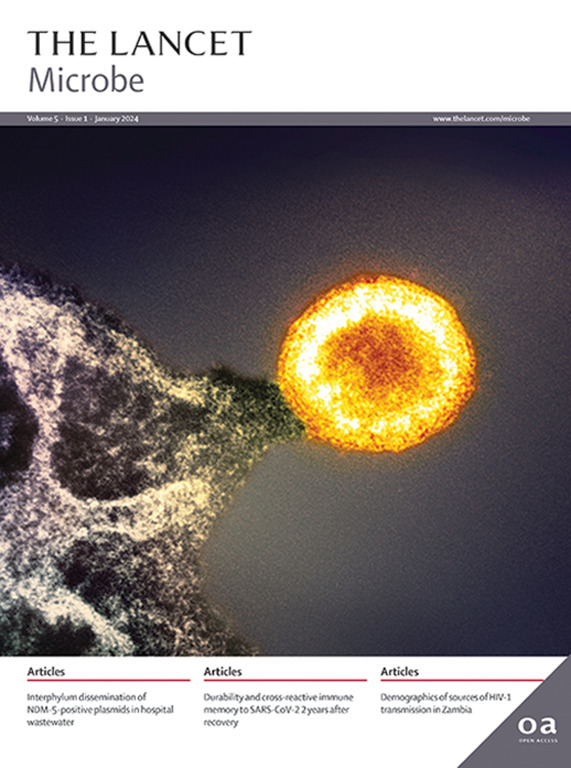Safety and immunogenicity of the ChAdOx1–MVA-vectored conserved mosaic HIVconsvX candidate T-cell vaccines in HIV-CORE 005.2, an open-label, dose-escalation, first-in-human, phase 1 trial in adults living without HIV-1 in the UK
IF 20.9
1区 生物学
Q1 INFECTIOUS DISEASES
引用次数: 0
Abstract
Background
An HIV-1 vaccine is long overdue. Although vaccine research focuses on the induction of broadly neutralising antibodies, challenging infections such as HIV-1 could require parallel induction of protective T cells. It is important to recognise that not all T cells contribute to protection equally. Previously, we developed a T-cell immunogen-based bivalent mosaic vaccine, HIVconsvX, delivered by vaccine vectors ChAdOx1 and modified vaccinia Ankara. In this study, we tested the HIVconsvX vaccine regimen for the first time in humans. Other ongoing trials will assess the contribution of the vaccine-induced killer T cells to the control of HIV-1.
Methods
HIV-CORE 005.2 was an open-label, dose-escalation, first-in-human, phase 1 trial done at the Centre for Clinical Vaccinology and Tropical Medicine, University of Oxford, Oxford, UK. Eligible participants were healthy volunteers aged 18–65 years living without HIV-1 and at a low likelihood of acquiring it. Because it was the first administration of ChAdOx1.tHIVconsv1 (C1) to humans, participants were assigned stepwise to two groups. Volunteer group 1 received a low dose of C1 on enrolment. Following a satisfactory safety review 7 days after vaccination, volunteer group 2 received a full dose of C1 boosted by vaccines MVA.tHIVconsv3 (M3) and MVA.tHIVconsv4 (M4) 4 weeks later in regimen C1-M3M4 and were followed up until day 140. Focusing on the full vaccine doses in group 2, the primary outcome was the local and systemic safety of the vaccine. The secondary outcome was the frequency and breadth of epitope recognition by vaccine-induced T cells determined by IFN-γ ELISPOT assay using peripheral blood mononuclear cells (PBMC) at peak (1 and 2 weeks after the M3M4 boost) and at the end of the study, assessed against volunteer’s pre-vaccination levels. The HIV-CORE 005.2 trial is registered at ClinicalTrials.gov (NCT04586673) and is closed.
Findings
Between July 3, 2021, and Aug 3, 2022, 13 participants were recruited and assigned to group 1 (n=3) and group 2 (n=10). Low-dose C1 was safe and well tolerated in group 1, and all three vaccine components were well tolerated in volunteer group 2. There were no serious adverse events. Local and systemic reactogenicities were consistent with intramuscular needle administration of immunogenic substances. All volunteers responded, and their vaccine-elicited T-cell frequencies peaked at a median of 4433 (IQR 2750–5820) IFN-γ spot-forming units per 106 PBMC and recognised a median of 9 (IQR 9-10) peptide pools out of 10, indicating that the responses were broadly specific and each vaccine recipient targeted at least nine epitopes on HIV-1. These frequencies were 7·4 times lower by day 140 (ie, 3 months later). T cells proliferated upon antigen re-exposure and displayed multiple effector functions, recognised variant epitopes, and inhibited HIV-1 from the four major global clades A, B, C, and D.
Interpretation
These results inform and support a programme of clinical evaluations of the HIVconsvX T-cell vaccines together with other cutting-edge tools for HIV-1 cure and prevention such as latency reactivating agents, passively infused combinations of broadly neutralising antibodies, and active Env-based vaccines or immunomodulators.
Funding
EU Horizon 2020 Research and Innovation programme, Medical Research Council and Foreign Commonwealth and Development Office Concordat agreement, European and Developing Countries Clinical Trials Partnership, National Institute for Health Research Oxford Biomedical Research Centre, and IAVI.
chadox1 - mva载体保守嵌合hiv - consvx候选t细胞疫苗在HIV-CORE 005.2中的安全性和免疫原性,这是一项开放标签、剂量递增、首次在英国进行的针对未感染HIV-1的成人的1期临床试验。
背景:HIV-1疫苗早就该问世了。尽管疫苗研究的重点是诱导广泛中和的抗体,但像HIV-1这样具有挑战性的感染可能需要平行诱导保护性T细胞。重要的是要认识到,并不是所有的T细胞都能起到同等的保护作用。在此之前,我们开发了一种基于t细胞免疫原的二价嵌合疫苗HIVconsvX,由疫苗载体ChAdOx1和修饰的安卡拉牛痘传递。在这项研究中,我们首次在人类身上测试了hiv - consvx疫苗方案。其他正在进行的试验将评估疫苗诱导的杀伤T细胞对控制HIV-1的作用。方法:HIV-CORE 005.2是在英国牛津大学临床疫苗学和热带医学中心进行的一项开放标签、剂量递增、首次人体一期试验。符合条件的参与者是年龄在18-65岁的健康志愿者,没有感染艾滋病毒-1,感染的可能性很低。因为这是第一次使用ChAdOx1。tHIVconsv1 (C1)为人类,参与者被逐步分为两组。志愿者1组在入组时接受低剂量的C1。在疫苗接种后7天进行满意的安全性审查后,志愿者2组接受了由MVA疫苗增强的全剂量C1。tHIVconsv3 (M3)和MVA。4周后,在C1-M3M4方案中进行tHIVconsv4 (M4)治疗,随访至第140天。重点关注第2组的全剂量疫苗,主要结局是疫苗的局部和全身安全性。次要结果是疫苗诱导的T细胞表位识别的频率和广度,通过IFN-γ ELISPOT测定,使用外周血单个核细胞(PBMC)在高峰期(M3M4增强后1周和2周)和研究结束时,与志愿者接种前水平进行评估。HIV-CORE 005.2试验已在ClinicalTrials.gov注册(NCT04586673),并已结束。研究结果:在2021年7月3日至2022年8月3日期间,招募了13名参与者并将其分配到组1 (n=3)和组2 (n=10)。在第1组中,低剂量的C1是安全且耐受性良好的,在志愿者第2组中,所有三种疫苗成分均具有良好的耐受性。无严重不良事件发生。局部和全身反应性与肌内注射免疫原性物质一致。所有志愿者都有应答,他们的疫苗引发的t细胞频率中位数达到峰值,每106个PBMC中位数为4433 (IQR 2750-5820) IFN-γ点形成单位,并且识别10个肽库中的中位数为9 (IQR 9-10),这表明应答具有广泛特异性,每个疫苗受体靶向HIV-1上的至少9个表位。到第140天(即3个月后),这些频率降低了7.4倍。T细胞在抗原再暴露后增殖,表现出多种效应功能,识别变异表位,并抑制来自全球四个主要分支A、B、C和d的HIV-1。这些结果为艾滋病毒consvx t细胞疫苗的临床评估规划提供了信息并为其提供了支持,该规划还包括用于治疗和预防艾滋病毒1型的其他尖端工具,如潜伏期再激活剂、被动输注广泛中和抗体组合以及基于env的活性疫苗或免疫调节剂。资助:欧盟“地平线2020”研究与创新计划、医学研究理事会和英联邦外交与发展部协议、欧洲和发展中国家临床试验伙伴关系、国家卫生研究所牛津生物医学研究中心以及国际艾滋病倡议。
本文章由计算机程序翻译,如有差异,请以英文原文为准。
求助全文
约1分钟内获得全文
求助全文
来源期刊

Lancet Microbe
Multiple-
CiteScore
27.20
自引率
0.80%
发文量
278
审稿时长
6 weeks
期刊介绍:
The Lancet Microbe is a gold open access journal committed to publishing content relevant to clinical microbiologists worldwide, with a focus on studies that advance clinical understanding, challenge the status quo, and advocate change in health policy.
 求助内容:
求助内容: 应助结果提醒方式:
应助结果提醒方式:


